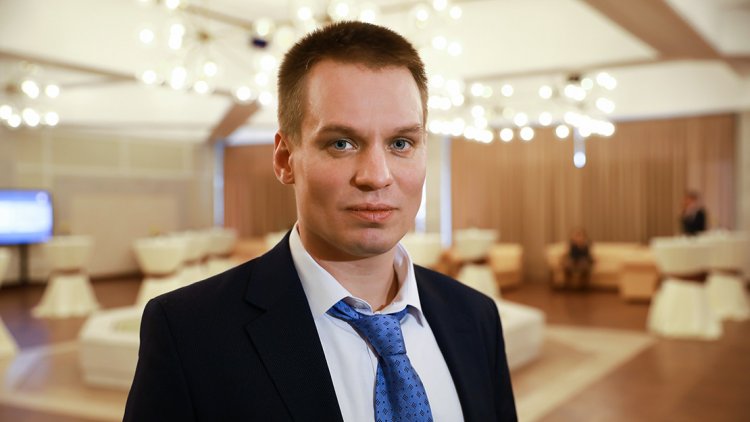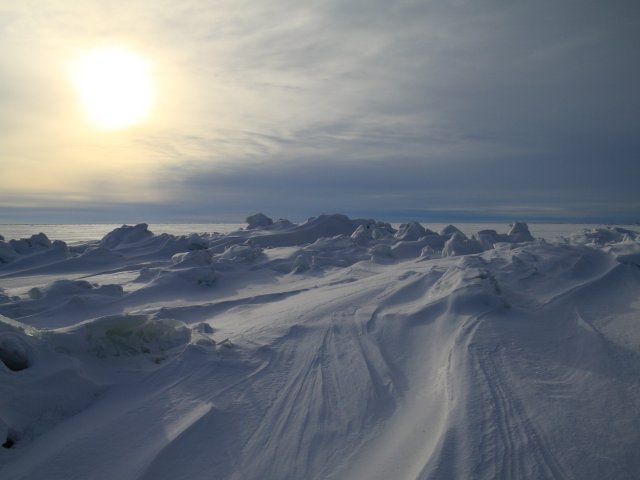How do physical factors, processes in the seas and oceans affect aquatic ecosystems? Why study the changes in phytoplankton blooms in different seas? Why do scientists need a system of automated changes in the deep part of the ocean? And how are these processes related to climate change?
Arseny Kubryakov, Candidate of Physical and Mathematical Sciences, winner of the Russian Presidential Prize in Science and Innovation, an associate of the Marine Hydrophysical Institute of the Russian Academy of Sciences, talks about this in an interview with Scientific Russia.
Arseny Kubryakov, Candidate of Physical and Mathematical Sciences, winner of the Russian Presidential Prize in Science and Innovation
Photo: Elena Librik / Scientific Russia
- You study the dynamics of processes in the seas and oceans, and their impact on the biological characteristics of ecosystems. How relevant is this topic today and how much do we know about aquatic ecosystems? After all, they have been studied for decades.
- It was the dynamics of the oceans that became my topic. The fact is that when I came to science, completely new data from satellite altimeters appeared, which allow us to determine the sea level and the speed of currents in the entire world ocean. Today, thanks to these methods, we have daily maps of surface current speed – these are completely new data that have given a huge amount of information. Now it is the basis for all models of ocean dynamics.
We have developed a number of geophysical corrections that have made it possible to refine the quality of these data and to determine new parameters of currents in the Black Sea and began to analyze them. This allowed us to get information about why the structure and intensity of currents vary so much from year to year. In some periods, the main element of the circulation of the Black Sea – the Main Black Sea Current completely disappears and the whole sea is filled with powerful vortices measuring 20-100 km. It turned out that the regime of currents is extremely important since it determines the transfer of nutrients from shelf areas, where there are many of them, to the central parts of the sea, where there are not enough nutrients. A connection emerged between dynamic processes and the ecosystem, and we began to develop interdisciplinary topics, using satellite measurements in the optical range for the analysis of biological characteristics.
Today, new research methods are emerging, and there are a lot of them: high-resolution satellite measurements, unmanned aerial vehicles, which make it possible to obtain completely new information. We try to monitor the emergence of new methods and apply them to current ocean research.
- In your reports, you mentioned the link between marine ecosystems and climate change. Is this the main direction where you can apply the data you obtain? What other applied and fundamental goals do you pursue?
- Our main goal is fundamental research. We want to understand the mechanisms of formation of the field of currents, vortices in the ocean, how mixing, and the thermohaline structure of the ocean associated with these factors change. It is important to know how these physical processes affect the biological characteristics and development of a particular type of phytoplankton – why is there a lot of phytoplankton in one year, and much less in another? This is fundamental knowledge that affects the achievement of practical goals.
For example, the carbon cycle is an urgent topic related to the global climate agenda. In the process of photosynthesis, phytoplankton assimilates a large amount (estimated to be about 50%) of carbon dioxide, one of the most important greenhouse gases, and then transports it to the bottom during the settling process – this is how the “biological pump” occurs. To assess the carbon balance, the contribution of natural and anthropogenic factors to changes in the carbon cycle, it is necessary to understand what causes and variability of phytoplankton blooms depend on.
There are other practical applications. For example, modeling, forecasts of the state of ecosystems for any economic purposes. Phytoplankton is the main food for zooplankton, zooplankton is for higher trophic levels. We need to understand how the ecosystem is developing and what influences it to know, for example, where to direct fishing vessels or how to avoid overfishing, how to properly conduct aquatic farming – grow mussels, oysters, etc.
Photo: Elena Librik / Scientific Russia
- Since what year have these studies been conducted, and what oceanic changes have been recorded during this period?
- Our research is based on satellite measurements that have been available for several decades. Altimeters have been available since 1990, almost for 30 years. Data with the help of optical systems have been obtained since the early 2000s. New methods have also appeared: for example, satellite salinity measurements, since 2015. But these data have already shown results: for example, that plumes, which are formed by the outflow of rivers into the Arctic seas and occupy huge areas, can move in completely different directions from year to year. For example, the plume of the Lena River can go north from the mouth, penetrating far into the polar regions (up to 80°), and can go east near the shore to the Bering Strait. Depending on this, a field of currents is formed, which depends on the difference in salinity between the desalinated river and salty sea waters. In the case of the eastern spread, the East Siberian current increases, which changes the entire water exchange between the Arctic and the Pacific Ocean. In 2015, the plume moved to the north, and in 2016 to the east – why exactly so? Such changes greatly affect the ecosystem of the Arctic, and in particular, worsen the lighting conditions.
We study the same thing in the dynamics of the seas and oceans. There are long-term changes, there are interannual ones. There are completely abnormal situations when the current weakens to a critical minimum and causes a sharp restructuring of the ecosystem. We are studying the causes of these changes.
- Have you already noticed and confirmed any patterns in marine variability?
- Of course, understanding the causes of changes in the structure of circulation and phytoplankton is our main goal.
In the Black Sea, we confirmed the assumption that it is the vorticity of the wind that causes and affects the intensity of large currents. The larger the wind vortex, which is associated with the flow of the Caucasus Mountains, the stronger the Main Black Sea Current. But when this current weakens, large vortices form instead of it – this mechanism of connection of large currents with vortices is also the subject of our research.
The wind is also the main cause of plume movements in the upper layer. At the same time, as I have already said, powerful plumes partly form their own circulation. We study the mechanisms of the combined action of wind and self-organizing circulation associated with density differences on the dynamics and evolution of river water movement.
Recently, there have been many interesting phenomena associated with increased storm activity. Sharp storms, especially during summer, cause completely abnormal phytoplankton blooms due to the active mixing of layers and the rise of nutrients from the depth. Such blooms were practically not observed in the Black Sea before, but now they can last for several months.
An interesting phenomenon is being studied by my colleagues in the Sea of Marmara. Last year, the whole sea was covered with a rather thick layer of sea slime. What is it and where does it come from? Now we are trying to find out these reasons, which, in particular, may be related to the global temperature rise.
Due to winds and melting of ice, salinity changes, which affects the stratification of the sea – the less stratified the sea is, the easier it mixes. The Black Sea, for example, is becoming saltier, which means it is more easily affected by wind and winter cooling. All this enhances the flowering of phytoplankton. For example, we observe extreme blooming of coccolithophores – these are algae that cover themselves with calcareous scales that scatter light. In 2017, the blooming was 10 times more than usual, which was due to the restructuring of the salinity fields caused by long-term climatic changes – increased wind speed and currents.
- Your work is very closely connected with biology. How actively do you cooperate with biologists, and can you partly attribute yourself to this science?
- Satellite measurements in the optical range give us information about various characteristics of phytoplankton and its blooming on the scale of seas and oceans. Profiling buoys gave us information about the vertical change in optical characteristics. And these optical characteristics are directly related to biological ones: for example, to chlorophyll A concentrations or particle concentrations.
We were joined by leading biologists from the Institute of Oceanology of the Russian Academy of Sciences. First of all, this is Alexander Sergeyevich Mikaelyan. At the Institute of Oceanology, there is a group of Andrey Georgievich Zatsepin, who loves both physics and biology – we also cooperate with them. Thus, our teams have strengthened, and new results are obtained by combining these two sciences.
Since childhood I have loved biology, the secrets of life, and its development. And our work concerns one of the key mysteries of the planet: the study of the causes of changes in plant communities in the ocean – the cradle of life on Earth.
- During a meeting of the Presidential Council for Science and Education, you proposed adding a system of automated changes in the deep ocean to the climate monitoring system in Russia. Does such a system need to be created in Russia from scratch?
- Yes, unfortunately, there is no such system now. There are prototypes and test sites where instruments have been tested, including those created by Russian oceanologists. For example, the moored profiler Aqualog allows you to perform vertical measurements of many parameters at once.
Our institute has a unique scientific installation – an oceanographic platform installed in the sea, where automatic measurements of a number of parameters of the atmosphere and ocean take place. In the Arctic seas, except for the White Sea, there is no such system. The same can be said about the Far East. These works are not systematized, there are only isolated irregular installations based on the initiatives of individual scientists.
But existing installations also give a lot of results. Automated stations provide a large amount of new information about how various parameters change over time: temperature, salinity, illumination, and so on. And these data provide the key to understanding what is responsible for the formation of various processes in the marine environment.
Naturally, in the age of computer technology, it is necessary to make robotic measurements. The satellites only see the surface but cover the maximum area. During ship expeditions, you can get unique data: sampling, etc., but only at one point and at one time. And automatic, regular vertical measurements will give constant information. It will be possible to find out how the signal changes not sporadically, but all year round. For example, we do not know what happens in many seas in winter – there are few expeditions due to unfavorable conditions. Automated measurements will help fill this gap and reach a completely different level in a number of areas of oceanology, but this requires support from the state.
- Can any seas and oceans be singled out as the most interesting in your work?
- All seas are interesting in their own way. The Arctic is of the greatest interest now: it is being freed from ice, and ice means protection from wind-wave effects. Now the wind affects the processes in the seas even in those periods when it did not touch the surface before, the flow regime changes accordingly. The blooming of coccolithophores in the Barents Sea, which I mentioned above – due to the release of ice, it shifted a thousand kilometers to the east. The Arctic seas are also very interesting from the point of view of river outflows that depress the ecosystem.
In the Pacific seas, there is another interest: there is an intensive formation of vortices, for example, the Kuril – they are very powerful due to the presence of a deep-sea trough that stabilizes them. These vortices cause a sharp transfer of nutrients and in particular, significantly change the fishing conditions.
Each sea is unique, and a separate story can be told about each. For example, the Baltic is covered with cyanobacteria, and there is a powerful blooming of these toxic algae. The Black Sea is famous for its anomalous salinity structure, which is partly the reason for the huge hydrogen sulfide zone in its deep layers.
- Crimea, where you work, is a water-deficient region. What is the noticeable connection between marine and freshwater ecosystems, and what research are you doing in this area?
- Our institute is working in this direction. One of the contracts is related to the study of freshwater sources. First of all, these are karst waters, and this is also largely due to the climate and precipitation distribution. Regional atmospheric models are being developed at the Institute, which more accurately show where precipitation falls most intensively, and, accordingly, more freshwater will be collected.
One of the important links between marine and freshwater ecosystems is river runoff, which carries a lot of minerals. On the other hand, the sea is a source of moisture, and when the evaporation conditions change, the characteristics of precipitation also change. In this sense, the entire world ocean is a connected system.
- In which direction will you continue your research? What will you pay special attention to, and which topics seem to be the most promising?
- In the near future, my colleagues and I plan to apply for a study of the Southern Ocean – Antarctica and the Subantarctic. We plan to study, among other things, its biological characteristics: a huge amount of new data has appeared there related to the launch of an international program of profiling buoys. This is an idea for the coming years.
We are actively engaged in unmanned technologies that allow us to obtain completely new data on coastal dynamics. Today, drones provide very high detail with the ability to watch videos. And video is an observation of the evolution of processes. Based on these measurements, we develop methods for determining the velocity of currents and waves.
We are also developing physico-biochemical models that allow us to fully take into account the influence of physical factors on the ecosystem. And the big dream is to create the very network of deep-sea measurements that will give very important answers to many questions of oceanology.
Photo: Elena Librik / Scientific Russia

























